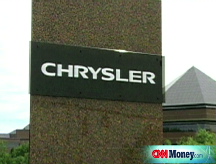Clock is ticking for GM and Chrysler
Automakers have four weeks to show the government they can cut costs. The UAW thinks the deadline is 'unattainable' but some say hard work has been done.
NEW YORK (CNNMoney.com) -- General Motors and Chrysler LLC have four weeks to win deep concessions from unions and creditors to prove they are viable, or they risk losing the $17.4 billion in government loans that are keeping them from bankruptcy.
But there are serious questions as to how great that risk is and what exactly GM and Chrysler have to show the government.
For example, the emergency-loan term sheet says only that the companies "shall use their best efforts to achieve" targets for labor-cost savings and debt reduction.
The term sheet also says that GM (GM, Fortune 500) and Chrysler have to reduce unsecured debt by two-thirds, but it is not specified how many of the creditors have to agree to exchange debt for stock.
It is also not clear whether the automakers need to have all the cost-savings agreements in place by Feb. 17, or whether simply laying out a plan will be sufficient.
United Auto Workers president Ron Gettelfinger said Monday that he thought the Feb. 17 deadline for GM and Chrysler to submit restructuring plans is "unattainable."
But some argue that GM and Chrysler may have already done enough with the union to satisfy the government, particularly when it comes to wages.
Last week, GM President Fritz Henderson told analysts that the company could meet the goal even if the UAW did not agree to pay cuts. "Does it require a wage cut? The answer is no," he said.
Henderson added that changes made in the 2007 labor deals already allow the automakers billions in savings, and that with those changes "it turns out there's not a significant difference" between what UAW workers make and employees at nonunion plants operated by Toyota Motor (TM), Honda Motor (HMC) and others.
Other experts agree that there has been more progress than is widely believed, and say that GM and Chrysler are close to being able to break even, and that's in a time of very depressed auto sales.
"They've been working at this a long time. It didn't start last fall," said David Cole, chairman of the Center for Automotive Research.
A GM spokesman said that the company was "working to further clarify the provisions of the agreement and we expect to meet all the applicable requirements."
Chrysler, which announced on Tuesday that it was entering a strategic alliance with Italian automaker Fiat, did not return calls for comment. A spokeswoman for the Treasury Department did not return calls seeking clarification.
But some critics of the Big Three believe that the companies are not serious about making the painful changes they need to be truly competitive.
"This is like an alcoholic who is drinking two quarts a day, saying he'll go down to one quart a day," said University of Maryland business professor Peter Morici.
A yet-to-be appointed federal regular will take the information filed by GM and Chrysler and will have until March 31 to decide if their plans make them viable for the future.
The automakers don't have to be profitable by March 31. They only need a plan to prove that they are on the road back to profitability. If the regulator decides the plan does not satisfy the terms of the loan, GM and Chrysler would have 30 days to repay the loans.
But few believe that this will happen.
"The worst case is they never quite make it back to where they need to be to be competitive and the government keeps throwing money in every quarter to keep them viable, like they've been doing with the banks," said one auto expert who asked that his name not be used.
To that end, some believe that the final cost of an auto bailout will not only be well above the $17.4 billion in loans to GM and Chrysler but even the $34 billion that GM, Chrysler and Ford Motor (F, Fortune 500) sought from Congress last month. Morici said the final cost could top $100 billion. ![]()


